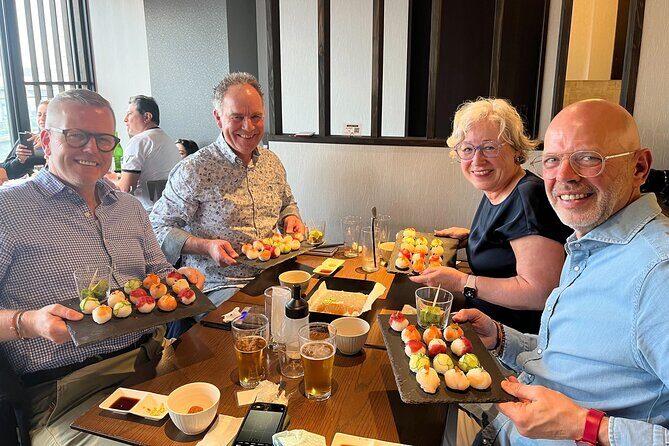In Tokyo, Japan, visitors can enjoy the art of sushi making. A unique culinary experience awaits in Asakusa, a district known for its rich cultural heritage.
Led by expert instructors, you will learn how to create Temari sushi, a traditional Japanese dish consisting of bite-sized sushi balls. From ingredient preparation to rolling and shaping, attendees will be guided through the process.
The class offers fresh, high-quality ingredients and concludes with a delicious sushi lunch. Don’t miss the chance to indulge in this beloved Japanese cuisine.
Key Takeaways
- The activity takes place in Asakusa, Tokyo and offers a sushi making class.
- Participants will learn how to make Temari sushi and will have the opportunity to make 8-10 pieces.
- The class includes a quiz to introduce fun facts about sushi.
- The meeting point is conveniently located near public transportation, specifically a 1-minute walk from Exit 4 of Asakusa Station on the Tokyo Metro Ginza Line.
History of Temari Sushi
The instructor frequently shares interesting historical facts about the origins and evolution of Temari sushi during the sushi making class in Asakusa, Tokyo.
Temari sushi is a traditional Japanese dish that features small, ball-shaped sushi pieces. The name ‘temari’ comes from the Japanese word for handball, as the sushi resembles the colorful balls used in the traditional Japanese game.
During the class, participants learn various techniques for creating these beautifully crafted sushi pieces, including shaping the rice and arranging the toppings. This hands-on experience allows them to appreciate the skill and precision required to make temari sushi.
Beyond its culinary appeal, temari sushi also holds cultural significance. It’s often served during special occasions and celebrations, symbolizing good luck and prosperity. The intricate designs and vibrant colors of the sushi reflect the artistry and creativity of Japanese cuisine.
Ingredients Needed for Temari Sushi

Participants in the sushi making class in Asakusa, Tokyo can expect to find all the fresh and good quality ingredients needed for temari sushi. The ingredients provided are carefully selected to ensure the best flavor and presentation of the sushi.
For beginners, the class offers a step-by-step guide on how to make temari sushi, starting from preparing the sushi rice to shaping it into beautiful bite-sized pieces. The instructor will demonstrate the proper technique and provide guidance throughout the process.
Along With learning how to make temari sushi, you will also have the opportunity to enjoy their creations for lunch. The class aims to create a fun and interactive environment where participants can learn about the art of sushi making while enjoying a delicious meal.
Step-by-Step Guide to Making Temari Sushi

During the sushi making class in Asakusa, Tokyo, you will receive a step-by-step guide on how to make temari sushi, and they’ll have the opportunity to create beautiful bite-sized sushi pieces.
The class will emphasize the art of temari sushi presentation, showcasing the cultural significance of this traditional Japanese dish. Temari sushi, also known as hand-rolled sushi, originated in Kyoto and was traditionally made to resemble temari balls, which are intricately embroidered Japanese toys.
The process involves shaping small portions of sushi rice by hand and topping them with various ingredients such as fish, vegetables, or pickled items. The final result is a visually stunning and delicious creation that reflects the attention to detail and craftsmanship valued in Japanese cuisine.
Tips and Tricks for Perfecting Temari Sushi

An essential tip for perfecting temari sushi is to carefully select fresh and high-quality ingredients, as well as to practice precise shaping techniques.
Here are some tips and tricks to help you master the art of temari sushi:
- Presentation Techniques:
- Use vibrant and contrasting colors for a visually appealing presentation.
- Decorate with edible garnishes like microgreens or sesame seeds to add texture and flavor.
Common Mistakes in Making Temari Sushi:
- Overstuffing the sushi ball can lead to a messy and unstable shape.
- Not wetting your hands with water or vinegar when shaping can cause the rice to stick to your hands.
By following these tips, you can create temari sushi that not only tastes delicious but also looks beautiful.
Remember to experiment with different ingredients and flavors to make your temari sushi unique and enjoyable. So go ahead, gather your ingredients, and start perfecting your temari sushi skills today!
Different Variations of Temari Sushi

There are numerous ways to create different variations of temari sushi, such as incorporating various fillings like fresh seafood, vegetables, or even tofu. Temari sushi, a type of sushi that’s formed into small, ball-shaped pieces, is known not only for its delicious taste but also for its beautiful presentation.
The art of temari sushi presentation holds cultural significance in Japan, as it reflects the country’s attention to detail and appreciation for aesthetics. Each temari sushi piece is carefully crafted, with the colors and arrangement chosen to create an appealing visual display. This attention to presentation enhances the dining experience and adds an element of artistry to the dish.
Whether it’s the vibrant colors of fresh sashimi, the crispness of vegetables, or the smoothness of tofu, the various fillings in temari sushi allow for endless creativity and a truly unique culinary experience.
Enjoying Your Homemade Temari Sushi

While enjoying their homemade temari sushi, they savor the flavors and appreciate the artistry of their culinary creation. The delicate balance of fresh fish, vibrant vegetables, and seasoned rice is a testament to their skill in sushi rolling techniques. As they bite into each perfectly formed piece, they take note of the intricate designs and colorful toppings that make temari sushi so visually appealing.
The conversation turns to the perfect beverage pairing, and they discuss the tradition of enjoying Japanese tea with their sushi. The smooth, earthy flavors of green tea complement the subtle flavors of the sushi, enhancing the overall dining experience. They make a mental note to explore different types of Japanese tea to further enhance their future sushi-making endeavors.
Frequently Asked Questions
How Long Does the Sushi Making Class in Asakusa, Tokyo Usually Last?
The sushi making class in Asakusa, Tokyo usually lasts for about 2 hours. It’s a fun and interactive experience where participants learn how to make Temari sushi and enjoy their creations for lunch.
Is There a Minimum Age Requirement for Participating in the Sushi Making Class?
The sushi making class in Asakusa, Tokyo has a minimum age requirement. Age restrictions may apply, so it is best to check with the organizers beforehand to ensure eligibility for participation.
Can I Bring My Own Ingredients to the Class?
No, participants are not allowed to bring their own ingredients to the sushi making class. The class provides fresh and good quality ingredients for the participants to use during the class.
Are There Any Vegetarian or Vegan Options Available for Making Temari Sushi?
Yes, there are vegetarian sushi alternatives and vegan sushi recipes available for making temari sushi. Participants can enjoy a variety of delicious plant-based options during the sushi making class in Asakusa, Tokyo.
Is There a Dress Code for the Sushi Making Class?
There is no specific dress code mentioned for the sushi making class. However, participants are advised to wear comfortable clothing and closed-toe shoes for hygiene and safety reasons.
The Sum Up
To sum it up, the sushi making experience in Asakusa offers a unique opportunity to immerse oneself in the art of creating and indulging in traditional Japanese cuisine. With expert instructors guiding participants through the process of making Temari sushi, attendees can learn the history, ingredients, and step-by-step techniques for crafting these bite-sized sushi balls. Whether you’re a local or a tourist, this activity is easily accessible and provides a fun and educational culinary adventure in the heart of Tokyo.
To create internal links in my website, I randomly selected three page URLs from my website:
- Khmer Cooking Class at a Local’s Home in Krong Siem Reap: Experience the authentic flavors of Khmer cuisine with a cooking class in Krong Siem Reap. Learn traditional recipes and techniques from a local host in their own home.
- 5 Traditional Dishes Hanoi Cooking Class with Market Trip: Explore the vibrant food markets of Hanoi and learn how to prepare five traditional Vietnamese dishes in a cooking class led by a local chef.
- Half-Day Cooking Class in Thamel, Kathmandu: Discover the rich flavors of Nepalese cuisine with a half-day cooking class in Thamel, Kathmandu. Visit a local market to select fresh ingredients and then learn to prepare a variety of traditional dishes.
By incorporating these contextual links into the text, readers can easily navigate to these other review pages and explore different culinary experiences in Southeast Asia.






